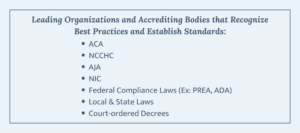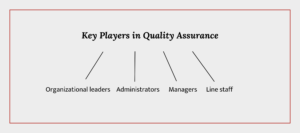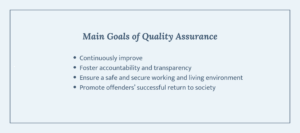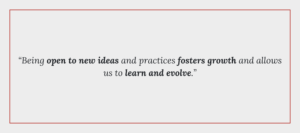
Raising the Bar – How to Ensure Your Detention Facility Meets or Exceeds Industry Standards
Speaking from Experience
Prior to joining CGL, I served at the Illinois Department of Corrections (IDOC), where I oversaw the agency’s Compliance Unit. In this role, I was involved in the inspection of process for 92 county jails and municipalities to ensure compliance with state statutes and best practices. I have more than 18 years of auditing experience directly related to IDOC’s internal and external reviews relative to the American Correctional Association and the National Institute of Corrections Standards.
All this is to say, many folks talk about “meeting standards,” but few actually have the firsthand knowledge of what goes into reviewing and auditing criminal justice facilities. As someone who’s actually been there, I’d like to take the chance to share my experience and provide some insight that I would have loved to have when I was first getting involved in the auditing process at IDOC.

The Lawrence Correctional Center (pictured here) was one of the facilities we inspected during my time as Chief Compliance Officer with the IDOC.
What Does Compliance Look Like?
How does a person know if they are performing well? As a young child, you may have been rewarded for good behavior, grades or that occasional clean room with praise from an adult or maybe even a special treat. As adults, the rewards may come in the form of a higher title, increased pay, a rewarding home life, or a simple “thank you” from a coworker or loved one. But how does an organization know it is performing well? Better yet, how does a detention facility know when it is operating at a level that meets or exceeds the industry standard?
Defining Standards – National vs. Local Standards and Resources to Guide You
In order to evaluate your organization’s success in meeting industry standards you must first determine what success looks like. National standards have a universal fit. However, the local laws and expectations of one state’s justice system may differ significantly from another’s. Research should be conducted to find out what standards and best practices exist in your specific industry. Industry trends should be reviewed, metrics should be determined, and benchmarks should be set. These steps will help to develop the facility’s policies and procedures while successfully guiding its mission.
There are many leading organizations and accrediting bodies that work to recognize best practices and establish standards. Organizations such as the American Correctional Association (ACA), the National Commission on Correctional Health Care and Mental Health (NCCHC), the American Jail Association (AJA), and the National Institute of Corrections (NIC), just to name a few. Federal laws requiring compliance with specific areas of concern such as the Prison Rape Elimination Act (PREA) or Americans with Disabilities Act (ADA) exist while many organizations may also find themselves required to comply with local or state laws or court-ordered decrees.

“Inspect What You Expect!”
Understanding what your organization must comply with is the easy part. What’s hard is ensuring compliance. Don’t just assume things are getting done as planned. Correctional facilities are complex organizations that depend upon the consistent performance of every staff person to ensure their operations. Even the best of us can get lax in our daily work performance from time to time. In order to ensure expectations are being met, inspections must be conducted early and often. Inspections allow for areas of concern or noncompliance to be identified and addressed, providing a consistent measure of deterioration or improvements.

There are several methods to “inspect what you expect.” Establishing a quality assurance system is vital to the improvement and ongoing success of any detention facility. Organizational leaders, administrators, managers, and line staff should all play an active role in this process.
The main goals of a quality assurance system should be to continuously improve, foster accountability and transparency, ensure a safe and secure working and living environment, and promote offenders’ successful return to society. It can help facilities and agencies alike determine the effectiveness of their own policies through an internal and external review process.

Important Considerations for Establishing Effective Compliance
An effective compliance process is not simply about checking boxes. It should be a dynamic and ongoing process that identifies areas for improvement and drives continuous improvement within the system. A needs assessment can help a facility identify specific challenges and assist in making informed decisions to further improve the living, learning, and working environment.
Another aspect to consider when conducting inspections or auditing for compliance is the infrastructure of the physical plant. It must be evaluated to ensure an adequate living and working environment is provided for staff and offenders. Without secure, well-functioning infrastructure that is supportive of the facility’s mission, programs focused on an offender’s behavior and rehabilitation may not succeed. The facility should provide a controlled, protective environment that prevents violence, destruction, and bad behavior. To determine whether or not your facility meets the needs of your current population and mission, a facility conditions assessment can be conducted. New approaches to detention can often be thwarted by a facility that is not conducive to its needs. Failing infrastructure can often prevent growth and adaptation of new procedures, not to mention being cost prohibitive and a drain on your budget. There are also lasting effects when it comes to hiring new staff or retaining current staff, which we all know is hard enough as is in the corrections community.
It’s important to not just focus on the bad. Inspections should also identify areas of excellence where facilities have implemented new or innovative practices that improve their performance. Highlight and celebrate these wins, and make sure they are shared across the agency to allow for agency-wide improvement.
Change Is Good – Be Open to It
While change is often seen as hard to implement in structured environments such as ours, we must open ourselves to change. Inspections and assessments should be utilized to identify strengths and weaknesses of the system or facility in question. These findings should then be utilized to plan and execute improvements, modify policies and procedures, and provide technical and monetary assistance when needed. Being open to new ideas and practices fosters growth and allows us to learn and evolve. By demonstrating a willingness to grow as an organization, it allows us to understand, adapt, and introduce new methods and techniques to effectively and efficiently address the myriad of issues that we face on a daily basis.

Each and every one of us learned to adapt and became acceptive of change during the pandemic. Why stop there? We have proven to be a resilient, transformative, and industrious community. A detention facility’s working environment is constantly changing due to technological advancements, new products and designs, and the ever-changing requirements and demographics of the offender population. There exists an increasing demand for sound, efficient security and operational practices while realizing the need to expand programming for the offenders in our custody. To determine where your facility culture stands, you can have a cultural assessment completed. This assessment determines the current cultural status and identifies actionable opportunities for improving that culture.
The Risk of Staying the Same
Over the course of my career, I have been fortunate to work in many different detention settings. One position in particular placed me in a correctional center whose roll call room floor included signs that stated, “Same Way Every Day.” It was a new state-of-the-art, closed-maximum security facility that would house the worst of the worst offenders. The signs on the floor were to serve as a reminder to correctional staff while they awaited their shift assignments: consistency, attention to detail, and repetition was vital to the facility operations and each staff person’s safety. We were taught to be consistent in performing our daily job duties, to not deviate from the training and guidance we had received and repeat these steps each and every day. In doing so, the facility and its staff would operate in a safe and efficient manner while providing the necessary security to effectively manage the offender population.
The initial concept was necessary and served its purpose. However, over time the “same way every day” mantra began to work against us. We forgot how to evolve and failed to grow along with the changing demographics of the offender population, evolving industry standards, and national trends for long-term segregation (restrictive housing). We became isolated from industry-leading concepts and unable to adapt to offenders’ evolving needs, leading to the facility being closed just 15 years after opening.

While consistency and adherence to routine are crucial for safety and efficiency in correctional facilities, an overemphasis on rigid repetition can hinder growth and adaptability. It is important to be open and adapt to change.
To Encourage Change, Establish a Positive Culture
It has been said that a facility’s culture is essentially its DNA. Just as it does for any winning (or losing, for that matter) sports team, the culture we establish defines us. It defines our attitude, beliefs, values, approach, and expectations. It lets others identify us. The lens we provide them with is up to us. The ability to successfully implement change in a correctional environment is dependent upon the facility’s culture. Those that have established a positive culture are more able to make and adapt to change, while those with a negative culture struggle with the most minor of changes.
Detention and security environments typically possess high expectations for compliance. In these settings, a positive and ethical workplace culture is crucial. A valued workforce can lead to a high morale and job satisfaction rate. This has an impact on your facility’s ability to hire new staff and increase retention levels. A facility’s willingness to undergo internal and external evaluations, focus on meeting or exceeding industry standards, and proactively identify areas of concern or improvement sets a positive tone. It shows staff, offenders, and key stakeholders that the facility and its leadership team are driven to be the best. The support of promotional and educational opportunities indicates an investment in the facility’s best resources – its staff.
As one would expect, a negative culture makes it difficult to retain staff, and new recruits are hard to convince to join the workforce. Negative cultures often resemble a lack of communication, decreased productivity, and failure to follow guidelines. The impact extends beyond those operating the facility. Unfortunately, both positive and negative cultures have a direct impact on the ability of offenders to succeed in the detention environment. Lack of success or opportunities can often lead to idle time, poor decisions, and potentially bad behavior.
Measuring Up
In the end, the only way to know if your facility measures up is to put it to the test. As previously mentioned, there are a number of opportunities to evaluate your facility’s level of compliance with industry standards. These include internal inspections and audits, which can be conducted to determine compliance with written law and established policies and procedures. Feeling overwhelmed at the thought of taking on such an important task? There are also knowledgable partners who can assist your agency or organization in conducting an unbiased, thorough assessment to help you meet the standards you desire. Peer reviews and certifications from outside agencies can be utilized to evaluate your facility against industry standards.
Remember – while any inspection, accreditation, or certification process can at times be grueling, they can also be extremely rewarding. Achieving this goal is not an individual endeavor. It takes the whole team being onboard to truly accomplish the goal at hand. The process of working towards compliance establishes a comradery that is essential to achieving the mission in front of us. It will require a positive culture, a willingness to correct the ship, if need be, and a full understanding of the evaluation processes and standards applied.


